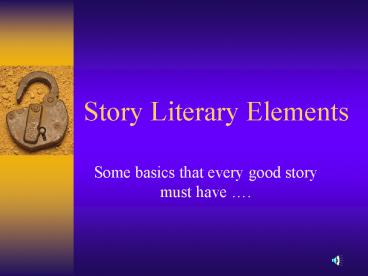Story Literary Elements - PowerPoint PPT Presentation
1 / 16
Title:
Story Literary Elements
Description:
Story Literary Elements Some basics that every good story must have . The time and place of the story is the setting the where and the when of a story The point ... – PowerPoint PPT presentation
Number of Views:348
Avg rating:3.0/5.0
Title: Story Literary Elements
1
Story Literary Elements
- Some basics that every good story must have .
2
The time and place of the story is the
settingthe where and the when of a story
3
The point of view is the perspective the story is
told from
I was framed! I just wanted to borrow a cup of
sugar!
That rotten wolf tried to eat us!!!!
4
First Person
- Uses words like I, me, we.
- The narrator is a character in the story.
- We know ONE CHARACTERS thoughts, feelings, and
actions
5
Third Person Limited
- Uses words like he, she, they.
- The narrator is NOT a character in the story.
- We know the thoughts and feelings of only a few
(limited ) characters.
6
Third Person Omniscient
- Omniscient omniall scientknowledge
- Uses words like he, she, they.
- The narrator is NOT a character in the story.
- We know the thoughts and feelings of many
characters in the story.
7
Why Is Point of View Important?
- The narrators point of view determines what and
how much you learn about the storys characters,
events, and places. - You have to know if you should believe the
narrator - How much does this narrator know and understand?
- How much does this narrator want me to know?
- How would this story be different if someone else
were telling it? - Can I trust this narrator?
8
Every story needs characters
- People
Animals
Or Creatures
9
The protagonist is the good guy
10
The antagonist is the bad guy
11
PLOT DIAGRAM
The sequence or order of events in a story.
Climax
Rising Action
Conflict
Falling Action
Exposition
Resolution
12
PLOT
- Exposition- This usually occurs at the beginning
of a short story. Here the characters are
introduced. We also learn about the setting of
the story. Most importantly, we are introduced
to the main conflict (main problem). - Rising Action - This part of the story begins to
develop the conflict(s). A building of interest
or suspense occurs.
13
More PLOT
- Climax - This is the turning point of the story.
Usually the main character comes face to face
with a conflict. The main character will change
in some way. - The Oh my gosh moment. You ask yourself,
Whats going to happen next?!
14
More PLOT
- Falling Action - All loose ends of the plot are
tied up. The conflict(s) and climax are taken
care of - Resolution - The story comes to a reasonable
ending.
15
Conflict (internal and external)
- Conflict - Struggles or problems between
opposing. The problem that must be solved. - Types-
- Character versus character-
- two characters against each
- other. An argument or
- disagreement
- Character versus self- a character battling her
own internal struggles/mind - This is Internal conflict!!!
16
Conflict
- Character versus society/world-disagreement with
societys values, law, or beliefs - Character versus nature-a struggle against
weather, land, animals, etc.

